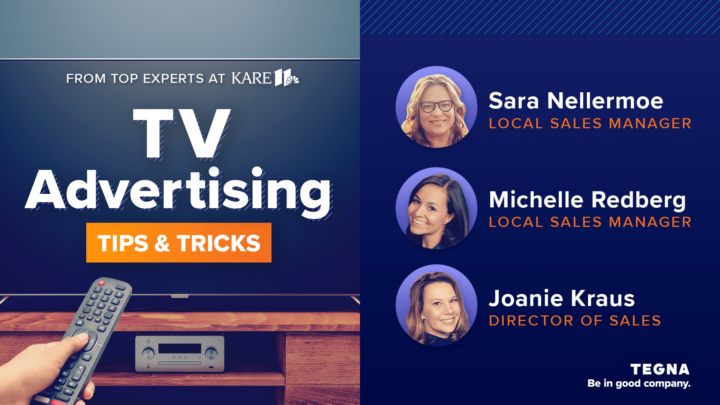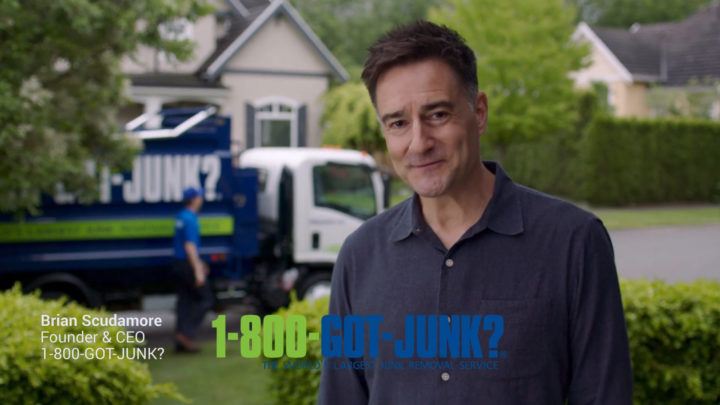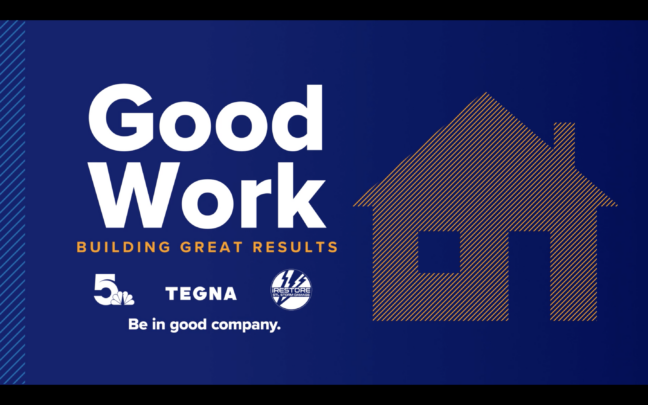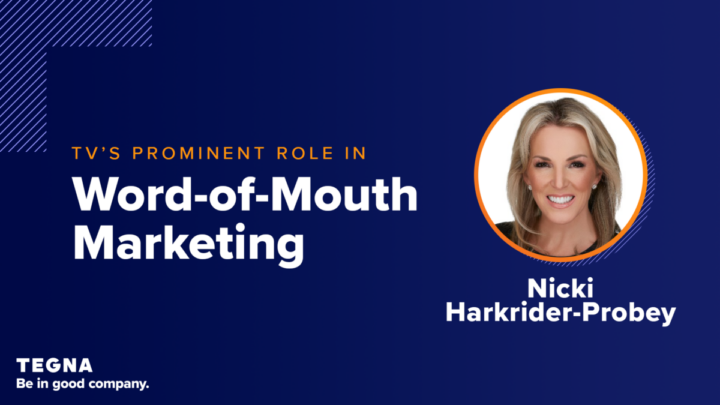Making TV Ads with TEGNA’s Top Experts
TV advertising is the most economical way to reach your brand’s ideal audience. But how do you create ads that move the needle? And where do you place them? KARE 11’s Joanie Kraus, Michelle Redberg, and Sara Nellermoe are here with their best practice tips and tricks to help brands grow business with strong TV advertising.

TV advertising is an important staple in American culture, from the catchphrases you’ll never forget to the jingles you can’t get out of your head. Not only is watching TV one of America’s favorite pastimes, but TV ads are also the top way to influence a consumer’s buying decisions, earn brand recognition, and build brand fame in the local community or on a national stage.
But how do you make TV ads that move the needle? And where do you place them?
For brands looking to jump into TV advertising, we’ve collected best practice tips from three amazing TV advertising experts at TEGNA’s KARE 11 in Minneapolis, Minnesota. Here’s what we can learn from Joanie Kraus, Director of Sales; Michelle Redberg, Local Sales Manager; and Sara Nellermoe, Local Sales Manager.
Why Should You Consider TV Advertising?
With so many places to advertise your brand, what makes TV so great? Why not send an email, put up a billboard, or place ads on social media?
“We know that viewing habits are evolving, and the landscape has changed,” says Nellermoe. “However, broadcast television is still the largest megaphone there is. It’s the best way to reach the largest audience and build brand awareness – and when you pair the traditional TV viewer and the digital streaming viewer together, that megaphone nearly doubles.”
Redberg agrees.
“No one does brand awareness better than television, and that’s because it’s audiovisual. It lets brands tell a story, using sight, sound, and motion to create emotion so viewers get the feel of the brand and get to know it on an intimate level,” says Redberg. “And when you pair high reach with the power of video, TV advertising is one of the most effective advertising platforms there is.”
What Kinds of TV Advertising Exist?
When people think about TV advertising, they usually think of the 15 or 30-second spots they see in between their content – what you would normally think of when you think “commercial break.” But TV ads aren’t limited to these traditional spots. For example, KARE 11 offers the opportunity for brands to appear on their Lifestyle Show, Minnesota & Company.
“For brands, that’s really where you can tell stories and history behind a company. They can communicate what makes them different beyond the 30 seconds they get with a traditional ad or what they can put in a clickable display ad,” says Nellermoe.
“Spot commercials are a frequency driver. It’s telling a story briefly and creating enough intrigue for viewers to buy or find out more online,” adds Redberg. “Then, our long-form lifestyle segments provide more of an education. It’s an organic ‘tell me about your product’ format. It’s not a frequency driver, but it’s like going to get coffee with a friend.”
Redberg also dives into the psychology of why long-form ads work. “With traditional advertising, there’s an inherent psychological barrier that comes up that says ‘you’re trying to sell me something.’ When put in a lifestyle format, it’s an interview style and more focused on client benefit, so it breaks down those walls,” says Redberg.
What types of brands benefit most from lifestyle and long-form advertising on TV?
Kraus believes businesses with more complex products and services will benefit the most.
“High-value goods and services will have a higher need for the consumer to understand a purchase,” Kraus explains. “If people are just price shopping, they can do that through a 30-second spot. If you want to talk through your solutions and why people would invest in you, long-form is where you go through all the benefits.”
“I recommend building a higher frequency in spot schedules, but having that sales-friendly lifestyle show, telling your story, having viewers resonate with the message, and develop that emotional connection will compel them to pull the trigger and buy,” Kraus adds.
Nellermoe adds, “Long-form shows off the extra things that don’t always get into the commercials. The viewer may ask, ‘Why do I want to use this roofing company?’ They can learn on the show that this company will be the ones who clean up and pick up all the extra nails when they’re done. You’re not going to have a flat tire after they leave. Those extras don’t always end up in the 30-second commercials. Sometimes they do, but not always.”
8 Tips for Making Successful TV Advertisements
“Marketing 101 is about reaching the right people with the right message and enough frequency to compel them to action,” says Redberg. But that might be easier said than done. Here are our best practice tips to help create the right message to reach an ideal audience with the perfect frequency.
1. Partner with Local News Stations
“Every business, to some degree, is competing against the Amazons of the world or that cheap mass distributor,” says Nellermoe. “Research backs an inherent correlation between someone engaged with a local station and wanting to support a local business.”
That’s because audiences have a great deal of trust in their local news stations. TVB found that local broadcast news is the most trusted platform for viewers. Drilling down deeper, Mastering the Millennial Mindset found that 43% of millennials surveyed trust their local news station, and 41% believe their local news stations care about the community it serves – and this halo extends to the brands that advertise alongside these platforms. Studies show consumers are more likely to trust – and buy from – brands that advertise alongside sources of information they trust, such as local TV news stations.
That station engagement and loyalty, for Redberg, is key. “We know a KARE 11 loyalist is a KARE 11 loyalist, so why not associate your brand with our brand on every platform?” asks Redberg. “People turn to us for breaking news or severe weather, and even though they can get it from other places, they’re coming to us. We’ve got research showing we are the most involved in the community and have the highest trust in the market.”
2. Understand Your Audience
“We use insights for anything and everything with our partners, whether placement or creative pieces, and I’ve found some really interesting stories,” says Kraus. “We researched the ideal consumer for one of our casino partners and found that a lot of people who go to casinos here in Minnesota are also avid gardeners.”
“In their ad, they added little gardening elements. It seemed totally random, but they actually found it to be extremely effective and led to a lift in attendance and revenue because the creative resonated with those people.”
Kraus adds, “It’s all about who the consumer is and really diving deep into that target audience, then threading the needle in very different ways to build those relationships and generate trust.”
3. Select Live TV
Live sports and events are key and leading the way with new highs in viewership for broadcast audiences. In fact, 113 million tuned into Super Bowl LVII, 12.55 million viewers tuned into the 2023 Grammy Awards, and the Women’s March Madness tournament also set new records for viewership.
“There’s a difference between live and entertainment formats, and we know that live events will have a different level of engagement, whether it’s live news or live sports,” says Nellermoe. “For example, Sunday Night Football in and of itself is a bigger audience, and because you’ve got so many viewers, that’s a great big microphone your brand can use.”
4. Consider Seasonality
TV advertising isn’t one-size-fits-all, so it doesn’t make sense for every brand to advertise year-round. Or does it?
“Businesses know they’re going to do well during their peak season. Everyone’s going to call their HVAC when it turns 90 degrees,” says Nellermoe. “Our power as a local news station can really help influence their shoulder seasons. Our goal is to get your brand ahead of that seasonality and get that awareness prior to everyone needing you because that’s what makes or breaks a year.”
5. Define Your Brand & Be Consistent
“As marketers, we know there’s power in consistency. We’re all distracted to a certain degree throughout life, so making your ad compelling – and with consistent branding – from every one of the senses is key,” says Redberg. “What does your brand look like? What does your brand feel like? What does your commercial look like? If I can’t hear it, what does your commercial sound like if I can’t see it?” asks Redberg.
“Your ads also need to be consistent with the brand and its values in tone, voice, and music selection,” says Nellermoe. “If your brand is a quiet, reserved financial firm, you don’t want to run an ad that is loud and in your face. Likewise, if your brand is a used car dealership, you’re not necessarily going to go after the quiet, reserved, simple classical music.”
6. Be Viewer-Centric with Creative
The key to great TV creative is showing how your brand will help solve a problem the viewer has. Redberg suggests keeping the viewer at the heart of your 30-second spot creative.
“Lead with listener benefit. I think a lot of times, especially on the local side, you hear a lot of people that want to talk about the history of their business – ‘my dad did this in 1932’ – and things like that. With TV ads, you must make it about the viewer rather than the brand.
7. Combine Linear TV with Streaming
As viewing habits change quickly, brands that thrive in this ever-changing ecosystem run campaigns combining linear and streaming.
“When we suggest combining broadcast and streaming TV platforms, we want to make sure that your brand is making an impact on every platform with that brand consistency and brand awareness we’ve been talking about,” says Nellermoe.
“We know there is an overlap in viewership, but it’s less than you would think of that traditional TV viewer and that digital streaming viewer. When you combine both reaches together, that megaphone nearly doubles. But, the overlap that is there? I would say it’s our friend, especially when considering brand awareness.”
8. Use Measurement Tools and Data to Optimize Campaigns
Not every advertising platform can provide data and insights to optimize campaigns throughout their run. Using a tool like TEGNA Attribution, you can collect real-time data for TV and streaming ads and connect them to outcome metrics such as website visits, app downloads, and more. This data can be used to prove the value of TV/streaming schedules to drive business results, make optimization decisions, and maximize the efficiency of paid media.
“With TEGNA Attribution, the proof is in the pudding. We’re looking at how viewers engage with your ads. We’re looking at the frequency and how much is needed for a viewer to act and purchase,” says Kraus. “We’re using data to ensure that we’re hitting the right people, to help build meaningful relationships, and show ROI with real-time results. With all of this working hand-in-glove, we can be the best advertising partner that we can possibly be.”
Examples of Successful TV Ads
At TEGNA and KARE 11, we have award-winning video commercial production capabilities, from creative concept through production. The following examples are just a few creative ways we’ve helped brands grow business nationwide.
By the Yard Getting Noticed with Fun & Relatable Commercials
By the Yard is a small Minnesota family-owned business creating outdoor furniture from recycled milk jugs. In a partnership with KARE 11, they developed quirky commercials for the Olympics that got people talking – and visiting their showroom.
“We love it when customers come into our showrooms or wherever they see us and say, ‘Oh my gosh, I remember when I saw your chair swimming in the pool,’” says Steidl. “That’s always our goal, to create a memorable, funny, tongue-in-cheek campaign. We create that moment for them, and it kind of gets them talking and keeps us top of mind.”
Replace or Repair that Roof? Kaufman Roofing Visits Minnesota & Company
In this sponsored appearance on Minnesota & Company, Kaufman Roofing’s Christine Deutsch joined the show to educate viewers on the importance of selecting the right roofing contractor. Deutsch also leveraged the platform to talk about what sets the brand apart from competitors in an authentic and organic way.
Pilgrim Cleaners Solves the Laundry Problem for KARE 11 Viewers
This 30-second ad for Pilgrim Cleaners follows the best practices outlined in this article. It leads by solving a problem for the viewer. The brand tone matches its services and, of course, aligns with its local news station, KARE 11, to target and bring in local customers for new and repeat business.
Sound Good? Partner with TEGNA for Your Next Ad Campaign
At TEGNA, our ultimate goal is to equip brands with data and insights to inform creative, then amplify those messages with cross-platform campaigns, including linear, streaming, and digital elements. With 64 broadcast stations in 51 markets nationwide, our unique content opportunities will connect your business to the audiences that matter most and deliver proven results Let’s get in touch to see how we can help your brand grow with the power of advertising.



















